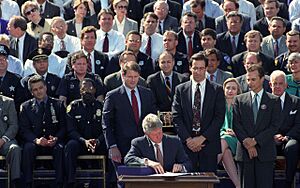Federal Assault Weapons Ban facts for kids

The Public Safety and Recreational Firearms Use Protection Act was a United States federal law. It is better known as the Federal Assault Weapons Ban (AWB or FAWB). This law was part of a larger bill called the Violent Crime Control and Law Enforcement Act of 1994.
The ban stopped companies from making certain semi-automatic firearms for regular people. These firearms were called "assault weapons." The law also banned certain large ammunition magazines. These were called "large capacity" magazines.
The ban lasted for 10 years. The U.S. Congress approved it on August 25, 1994. President Bill Clinton signed it into law on September 13, 1994. The ban only applied to weapons made after this date. It ended on September 13, 2004, because of a rule called a sunset provision. This rule meant the law would automatically expire after 10 years. Some people tried to challenge the ban in court, but the courts upheld it. There have been many tries to bring the ban back, but none have worked so far.
What the Ban Included
The Public Safety and Recreational Firearms Act was part of a bigger law from 1994. Its rules ended on September 13, 2004.
The law made it illegal to make, sell, or own "semiautomatic assault weapons." The law defined these weapons in specific ways. Some weapons were banned by their exact name or model. Others were banned if they had certain features. These features varied slightly for pistols, rifles, or shotguns.
The law also banned making "large capacity ammunition feeding devices" (LCAFDs). These are often called "magazines." An LCAFD was any device made after the law began that could hold more than 10 rounds of ammunition. However, magazines made before the ban were still legal to own and sell. These were known as "pre-ban" magazines. New LCAFDs could only be made for government, police, or military use.
Special Rules and Exceptions
The law had some important exceptions:
- A "grandfather clause" allowed people to keep and sell weapons and magazines they already owned legally.
- The law listed about 650 types of firearms that were not banned. These included models like the Ruger Mini-14 and Marlin Model 9 Camp Carbine.
- Some firearms were also not banned if they were operated manually. This means they used bolt, pump, lever, or slide actions. Also, firearms that were permanently broken or were antique were not banned.
- The law did not apply to semi-automatic rifles that could not use a detachable magazine holding more than 10 rounds. It also did not apply to semi-automatic shotguns that could not hold more than 5 rounds.
- Police officers and military personnel could still use these weapons. Retired police officers could also own them if they were not otherwise banned from owning firearms.
In 1989, the George H. W. Bush administration stopped the import of some foreign-made semi-automatic rifles. These were rifles that were not considered to have a "legitimate sporting use." This rule did not affect similar rifles made in the U.S. After the 1994 ban, the ATF decided that some imported semi-automatic rifles could no longer be brought into the country. This was even if they had been changed to remove military features. In 1998, the ATF banned the import of 56 such rifles.
What is an Assault Weapon?
Under the 1994 ban, a "semi-automatic assault weapon" (SAW) was defined in two main ways. Some specific models were banned by name. Other semi-automatic firearms were banned if they had two or more special features.
Here are some examples of features that could make a firearm an "assault weapon":
- Semi-automatic rifles that could use detachable magazines and had two or more of these:
- A folding or telescoping stock (the part that rests against your shoulder).
- A pistol grip (a handle that sticks down).
- A bayonet mount (for attaching a knife).
- A flash hider or a barrel that could attach one.
- A grenade launcher.
- Semi-automatic pistols with detachable magazines and two or more of these:
- A magazine that attaches outside the pistol grip.
- A threaded barrel for attaching things like a flash suppressor.
- A barrel shroud (a cover to prevent burns).
- Weighing 50 ounces (about 1.4 kilograms) or more when empty.
- Being a semi-automatic version of a fully automatic firearm.
- Semi-automatic shotguns with two or more of these:
- A folding or telescoping stock.
- A pistol grip.
- A fixed magazine that holds more than 5 rounds.
- A detachable magazine.
The law also specifically banned certain makes and models of semi-automatic firearms. This included any copies of them. Here are some examples:
| Name of Firearm | Status Before the Ban |
|---|---|
| Norinco, Mitchell, and Poly Technologies Avtomat Kalashnikovs (AKs) (all models) | Imports banned in 1989 |
| Action Arms Israeli Military Industries Uzi and Galil | Imports banned in 1989 |
| Beretta AR-70 (SC-70) | Imports banned in 1989 |
| Colt AR-15 | Legal |
| Fabrique National FN/FAL, FN-LAR, FNC | Imports banned in 1989 |
| SWD (MAC type) M-10, M-11, M11/9, M12 | Legal |
| Steyr AUG | Imports banned in 1989 |
| INTRATEC TEC-9, TEC-DC9, TEC-22 | Legal |
| Revolving cylinder shotguns like the Street Sweeper and Striker 12 | Legal |
See also
- Assault weapon
- Gun politics in the United States
- National Firearms Agreement (Australia)


